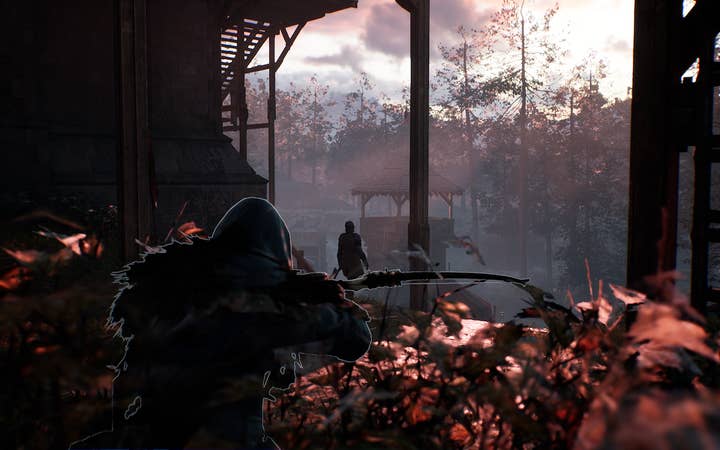How weapon capabilities influence environmental design and player movement
Lead game designer on Hood: Outlaws & Legends Jamie Smith explores how weapon mechanics can impact other areas
Hood: Outlaws & Legends is a third person, multiplayer heist game, set against a medieval-inspired backdrop -- think Payday meets Game of Thrones. Launching May 10, the game pits two teams against each other in a race to steal riches found within the imposing, heavily fortified structures of the state guards.
This article will focus on 'The Ranger' -- one of four playable character classes -- who represents a darker take on the folklore legend of Robin Hood, and how the design of the character and his signature longbow became entwined with environmental design, helping to overcome challenges posed by the game world and its inhabitants.
Infiltrating the competition
There are many successful third person games featuring a bow and arrow: Tomb Raider, Horizon Zero Dawn, and The Last of Us to name a few. The original approach taken with Hood: Outlaws and Legends was to leverage the strong fundamentals laid down by these titles in terms of controls, framing, and transitions.
There are many successful third person games featuring a bow and arrow. [Our] original approach was to leverage the strong fundamentals laid down by these titles
In a co-operative and competitive multiplayer scenario however, The Ranger is the equivalent of a sniper -- accurate and deadly over long distances. This is where our intentions began to diverge from those initial influences.
While excelling over range as a lone wolf was a core gameplay choice for The Ranger, we wanted to ensure that the following aspects of his playstyle were also accounted for:
- 1. Utility - Opportunities to synergise with teammates such as providing new routes by dropping ropes from grapple points or tagging enemy targets from high positions to share situational awareness with others, before springing an ambush. This is in addition to providing covering fire from both offensive and defensive power positions.
- 2. Satisfaction - Every arrow should feel powerful, like it's landing with the impact of a Barrett .50 caliber rifle. There should also be opportunities for the player to perform a Hail Mary; a last-ditch effort to prevent the enemy team from escaping. The kind of feats that wouldn't look out of place in a streamer's highlights reel.
- 3. Flow - Moving effortlessly through the world by transitioning over obstacles as if they aren't there, maintaining momentum and preventing player intent from being obstructed. Ultimately, this is about being able to seamlessly perform actions without being hampered by interactions or the environment.
All of the above factored into how we approached traversing through and interacting with the environment.
Environmental utility
The initial prototype for Hood began in Unreal Engine 4 by using various marketplace packages to flesh out the characters and game world. Beginning with a large-scale map, the idea was to populate the environment with mechanics for each team to overcome obstacles, before promoting a shared objective that would pull them together to encourage conflict.
These mechanics included doors that could only be opened by certain characters to create new paths, searching locations for a hidden key to the treasure vault, and claiming capture points for strategic respawn opportunities. This prototype map later became the basis for Citadel; a dense concrete fortress housing a strong, hostile presence.
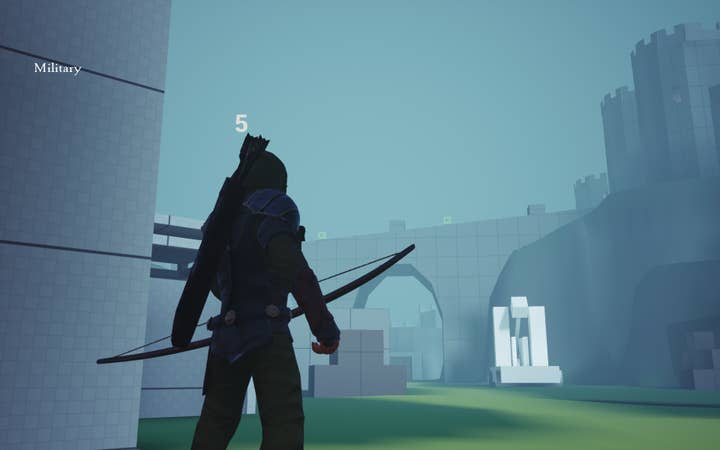
The Ranger struggled with many of these aspects, as his role is to scout the environment to identify targets and kill them to feather out enemy resistance. From an art perspective, the intention was to make a fortified castle-like structure to house the treasure, which would be physically imposing in size and could be seen from almost any position in the world.
This introduced a challenge for gameplay as elevation changes raised a number of questions about how to get up high quickly -- which heights were deemed dangerous for the player to fall from, and to what extent could the player shoot targets from above (or below). This in turn would further reinforce the need for The Ranger to survey their surroundings, but there was still an appetite to diversify his moveset further, the key ingredient just hadn't revealed itself yet.
Elevation changes raised a number of questions about how to get up high quickly
We already had ladders working in the game which could be used by both playable and non-playable characters, but some of them were too slow to use and didn't provide much of a gameplay advantage. This is when the lightbulb hit. What if we created a different type of "ladder" to serve the following purposes:
- It is not deployed by default but can be activated by a projectile.
- Once activated, it can be used by all playable characters but not AI guards.
- It is faster to descend than it is to climb.
- It is placed in locations where a tactical advantage or shortcut can be gained.
- Minimise enemy AI presence in the nearby vicinity.
Shortly after, the first version of a grapple point was born. Initially presented as a simple green box as a matching motif, it wasn't long before it became second nature for ranged players to keep their eyes peeled for alternate routes. It enabled opportunities to get behind enemy lines, while providing a secondary use for their longbow to create a path for teammates.
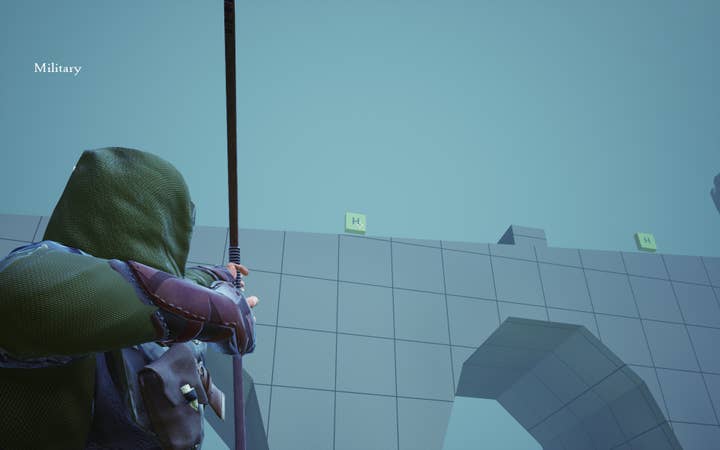
We used to describe it like shooting a bird box where the seeds would spill out, so this design was later refined into a protruding beam with a rope wrapped around it which would drop upon impact. We did consider a Jack Sparrow-style launch rope or having the ability to grapple to any raised surface, similar to the Arkham series, but ultimately those were ditched in favour of maintaining design control and environmental persistence.
Other prototypes, which used ropes as an ammo type and were able to retract deployed grapples, followed a similar fate. In the end though, we were satisfied that The Ranger now had a more strategic role in influencing the team's approach, both in and out of the fortress. The Ranger could now do so using the same intuitive mechanics for killing foes, which also had the added benefit of making it easy to teach during onboarding.
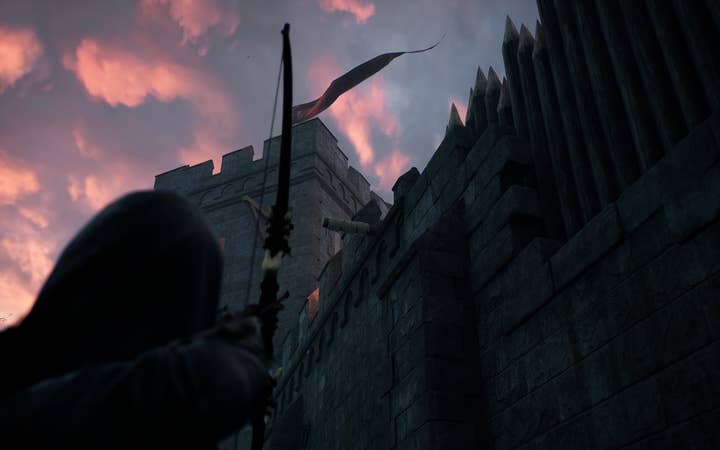
Satisfying sightlines
So now that the core shooting mechanics were defined, there was still a question of sightlines and map variety. This was both in terms of how far The Ranger was capable of shooting, which would determine the longest distance achievable for player skill and draw distance, and also the number of power positions -- high-profile locations ranged players would be attracted to for firing Hail Mary attempts.
Enemy AI soldiers were faded out of existence to cut down on gameplay resources, due to their increased population density
Some maps cater towards the needs of the Ranger and feature long sightlines and open spaces, whereas others are more restrictive with winding corridors and low visibility.
Defining the effective range was fairly straight-forward. Playtesting during the prototype stage revealed that 50 metres and above was always going to be a difficult, but satisfying, shot to pull off, as it required the player to lead targets and compensate for gravity. So, it wasn't long before we settled on 70 metres being the optimum achievable distance for The Ranger, which would promote some real wow moments from high skill players on stream.
This also helped to inform the technical side where enemy AI soldiers were faded out of existence to cut down on gameplay resources, due to their increased population density. Player characters on the other hand, are all drawn as far as the eye can see, though their visual and technical footprint is less in comparison.
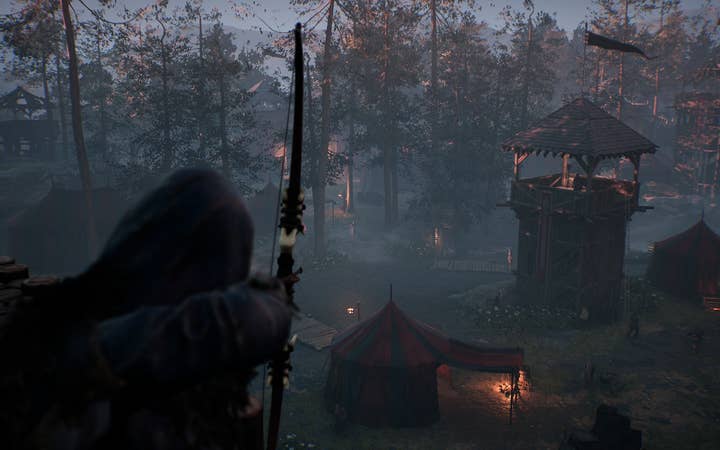
The same metric of 70 metres was used as a basis for plotting out sniper positions around the various maps. While some locations were prominent and exposed -- a clear weakness to The Ranger -- others were more covert and could lead to griefing.
We didn't want to mitigate player skill or limit the possibility of clutch save opportunities, but we did want to address this early, as there was potential for matches to become aggravating stalemates or solicit camping. Several different approaches were taken to counteract this, which included:
Taking inspiration from our old friend John Rambo, we revised The Ranger's ability to become an ethereal arrow which would explode shortly after impact
- Adjusting environmental visibility, such as pockets of fog or blankets of darkness making it difficult to perceive targets.
- Static obstacles, such as crates and trees that would only allow partial sight of an objective.
- Dynamically moving props, such as flags or boats that provide brief windows of opportunity.
- Ammo boxes that were intentionally placed away from crow's nests to encourage attacker repositioning and providing moments of respite for defenders.
- The aiming reticle always remains white even when an enemy is in view (in some games it transitions to red), and bushes help to hide targets, so this combination promotes more observational skill from ranged characters.
- Introducing a throwable gear item for Marianne, The Hunter class, which would temporarily cover exposed areas in a cloud of smoke.
In addition to the above, we chamfered edges of balustrades to increase comfort while shooting, making more of the map viable to explore and fire from, as opposed to relying on a handful of key locations. We also increased the distance for how close a player could get to geometry before lowering their bow, in some circumstances it meant there was some clipping, but this was seen as a greater good when factoring gameplay needs. Prior to making these changes, it was difficult to acquire targets due to chunky, hard edged walls throughout the game which often aggressively restricted player aiming.

Shooting around corners, also known as "peeking", is another common issue found within other competitive games where one player can shoot another player without being seen themselves.
We alleviated this by making sure that both targets and their weapons could line trace to each other without impediment, otherwise we would ensure that arrows would land in the blocking obstacle, with supporting player feedback to signify this outcome.

Finally, an early behaviour exhibited in the prototype was "meat-shielding" -- a frustrating and unintended defensive tactic where an enemy player would block an incoming arrow targeting an objective carrier. Even with an open sightline, it nullified the skill of a ranged player and failed to reinforce the idea of satisfying last-ditch kills as per the original intent.
Taking inspiration from our old friend John Rambo, we revised The Ranger's ability (initially a teleport dash -- similar to Blink in Dishonored) to become an ethereal arrow which would explode shortly after impact, dealing massive damage to anyone in range. Soon after its introduction, meat-shielding became an extremely dangerous option for defensive players as they were more likely to become a live detonator which would kill their teammates if they remained too close.
Maintaining flow
Positional advantage is key to success with The Ranger but there comes a time when escaping danger, blending into stealth, or having to restock ammunition takes precedence. The world of Hood: Outlaws & Legends is filled with gameplay ingredients that solicit each of these behaviours, with the ultimate goal of minimising friction, and The Ranger was our quality benchmarking test case.
Inspired by the fast rope in Rainbow Six Vegas, the idea was to maintain player momentum throughout the transitions
Grapple points provide a direct escape route out of each castle, and allow players to latch onto them and descend in a seamless motion. Inspired by the fast rope in Rainbow Six Vegas, the idea was to maintain player momentum throughout the transitions and to do so in a way that wasn't too jarring or disruptive in taking control away from the player.
Bushes are stealth ingredients that are clumped throughout the world which can mask player movement while in the crouched state. However, there was a particular issue to resolve for the longbow, which was that the dense foliage would become a line-of-sight blocker for The Ranger. This in turn would impact the gameplay cadence: position, survey, and shoot.
Other games tend to raise the character's crouching state or adjust the camera vertically, but given the competitive nature we opted for a tech art solution instead. This involved dithering out the edges of bushes, adjusting their transparency to reduce the impact on the player's focal point.
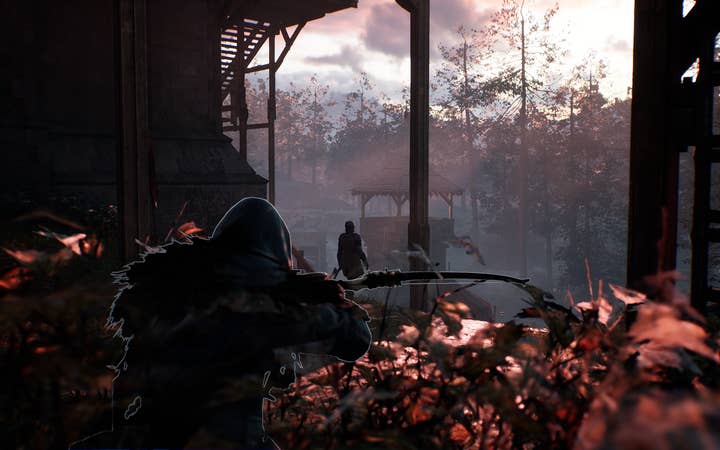
Numerous obstacles throughout the world, such as walls and fences, can be vaulted over or climbed upon. The player is vulnerable during the transition of course, but maintaining the sense of speed can be the difference between life and death in a game where a couple of hits can kill. This is especially true of smaller, less visible objects such as rocks. Many of which we simply disabled collision to prevent the player being snagged by something less than knee height which would be cropped off screen.
Ammo crates scattered around the map became clumsy interactions that hampered the player experience
Ammo management is another skill associated with The Ranger's playstyle but early on in development, ammo crates scattered around the map became clumsy interactions that hampered the player experience.
Having to press an input in proximity of a crate not only took attention away from the core objective of helping the team to steal the treasure, but encouraged the player to perform an unnecessary pitstop; a nuisance that slowed them down to perform a manual action and risking danger. It effectively became a double punishment that added to the frustration of being low on ammo.
With a swift and simple adjustment, ammo crates changed to become auto-collected into the player's inventory while gliding past. Then, an audit was carried out to evaluate the positioning of ammo crates, to place them closer to grapple points and common routes. The final touch was to highlight the outline of ammo boxes when the player's inventory was low to increase visibility. Shortly after these changes, ammo crates became much more like a revolving door, a thankless convenience on route to the intended destination.
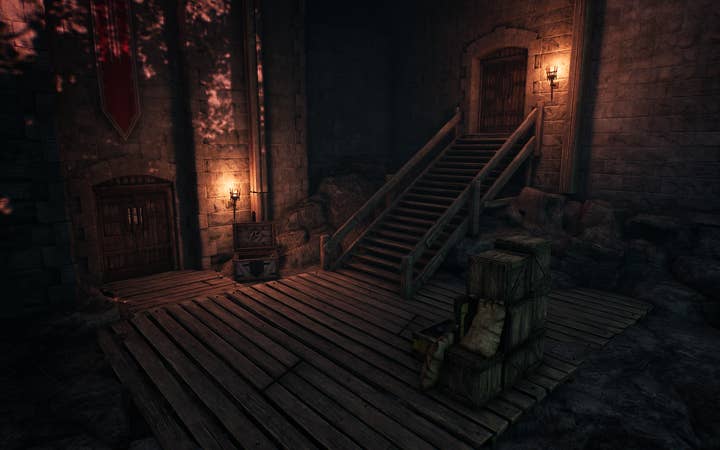
Exfiltrating development
We've been proud and privileged to have had the opportunity to bring a character in the vein of Robin Hood to life. There's a whole lot more to think about when competitive and thematic constraints combine with gameplay intent. The game world compliments these behaviours by providing utility options for teammates, satisfying opportunities to save the day, and enabling seamless traversal.
We'd always hoped for our bow and arrow mechanics to rub shoulders with the industry elite, and I think we've certainly done ourselves proud considering the modest team size. Now we're just excited to see the reception from the audience at large!
Jamie Smith is a lead game designer at Sumo Newcastle. His industry experience includes prolonged stints at both Ubisoft and Electronic Arts, most notably working as a designer on Tom Clancy's The Division and the FIFA franchise.
